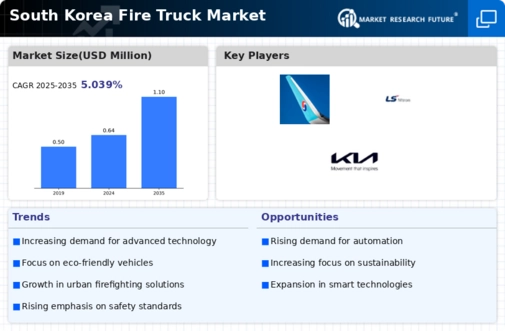The South Korea Fire Truck Market exhibits a dynamic and evolving landscape characterized by technological advancements and an increasing demand for robust firefighting solutions. With the ever-growing emphasis on public safety and emergency preparedness, the market has seen an influx of innovations aimed at enhancing the efficiency, reliability, and safety of firefighting operations.
Competitive insights reveal that various local and international players are vying for market share by integrating advanced technologies, sustainable practices, and customer-centric designs in their product offerings. A comprehensive understanding of competition in this sector highlights trends related to product development, customer preferences, and regulatory requirements, thereby informing strategies for market penetration and expansion. Hanjin Heavy Industries is a prominent player in the South Korea Fire Truck Market, renowned for its commitment to engineering excellence and innovation.
The company has positioned itself as a leader by focusing on the production of high-quality fire trucks that meet both local and international safety standards. Its product portfolio includes a variety of firefighting vehicles designed to cater to the specific needs of urban and rural fire departments.
Hanjin Heavy Industries benefits from a robust distribution network and strong relationships with local government agencies, which bolsters its market presence. The company’s strengths include its technological prowess, expertise in custom-built fire apparatus, and a strong reputation for reliability and performance. As fire safety regulations become more stringent, the company's adaptability to these changes solidifies its standing in the market. Samil Transportation Equipment is another key player in the South Korea Fire Truck Market, recognized for its diverse range of firefighting and emergency response vehicles.
The company has established a significant market presence by delivering customized truck solutions equipped with advanced firefighting technology and features tailored to the specific demands of emergency services in South Korea. Some notable products include specialized water tenders and rescue vehicles that have gained traction among municipal customers. Samil Transportation Equipment emphasizes innovation and quality, which positions it competitively against peers in the sector.
The company’s strengths lie in its strategic partnerships and collaboration with local authorities and fire services, enhancing its visibility and reach. Moreover, Samil Transportation Equipment has engaged in various mergers and acquisitions, which have allowed it to incorporate advanced technologies and expand its product line, further solidifying its market leadership in the South Korean fire truck industry.













